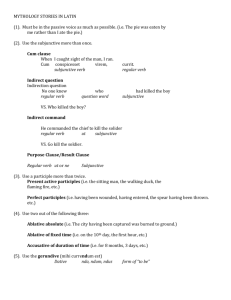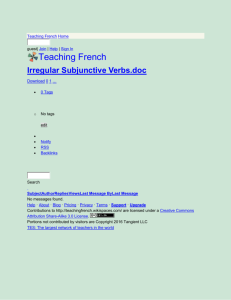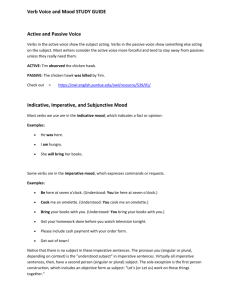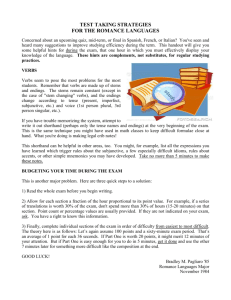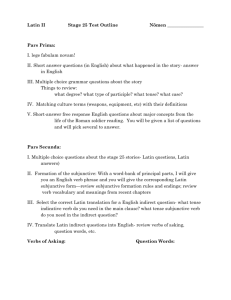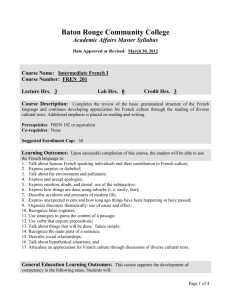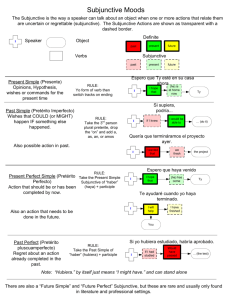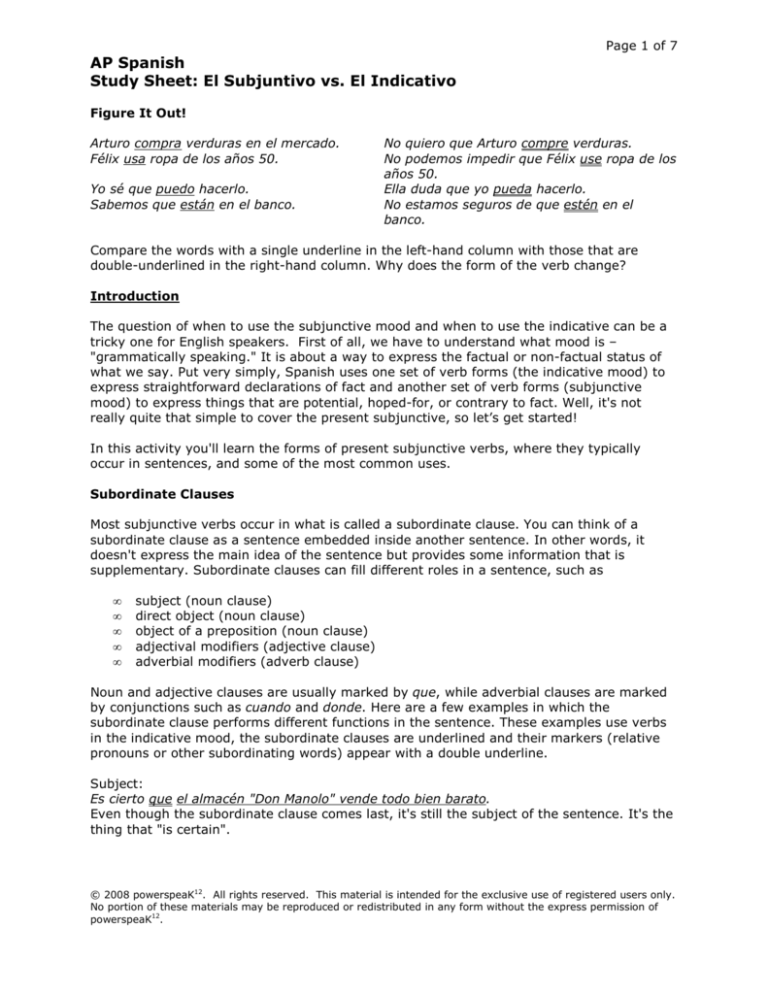
Page 1 of 7
AP Spanish
Study Sheet: El Subjuntivo vs. El Indicativo
Figure It Out!
Arturo compra verduras en el mercado.
Félix usa ropa de los años 50.
Yo sé que puedo hacerlo.
Sabemos que están en el banco.
No quiero que Arturo compre verduras.
No podemos impedir que Félix use ropa de los
años 50.
Ella duda que yo pueda hacerlo.
No estamos seguros de que estén en el
banco.
Compare the words with a single underline in the left-hand column with those that are
double-underlined in the right-hand column. Why does the form of the verb change?
Introduction
The question of when to use the subjunctive mood and when to use the indicative can be a
tricky one for English speakers. First of all, we have to understand what mood is –
"grammatically speaking." It is about a way to express the factual or non-factual status of
what we say. Put very simply, Spanish uses one set of verb forms (the indicative mood) to
express straightforward declarations of fact and another set of verb forms (subjunctive
mood) to express things that are potential, hoped-for, or contrary to fact. Well, it's not
really quite that simple to cover the present subjunctive, so let’s get started!
In this activity you'll learn the forms of present subjunctive verbs, where they typically
occur in sentences, and some of the most common uses.
Subordinate Clauses
Most subjunctive verbs occur in what is called a subordinate clause. You can think of a
subordinate clause as a sentence embedded inside another sentence. In other words, it
doesn't express the main idea of the sentence but provides some information that is
supplementary. Subordinate clauses can fill different roles in a sentence, such as
•
•
•
•
•
subject (noun clause)
direct object (noun clause)
object of a preposition (noun clause)
adjectival modifiers (adjective clause)
adverbial modifiers (adverb clause)
Noun and adjective clauses are usually marked by que, while adverbial clauses are marked
by conjunctions such as cuando and donde. Here are a few examples in which the
subordinate clause performs different functions in the sentence. These examples use verbs
in the indicative mood, the subordinate clauses are underlined and their markers (relative
pronouns or other subordinating words) appear with a double underline.
Subject:
Es cierto que el almacén "Don Manolo" vende todo bien barato.
Even though the subordinate clause comes last, it's still the subject of the sentence. It's the
thing that "is certain".
© 2008 powerspeaK12. All rights reserved. This material is intended for the exclusive use of registered users only.
No portion of these materials may be reproduced or redistributed in any form without the express permission of
powerspeaK12.
Page 2 of 7
AP Spanish
Study Sheet: El Subjuntivo vs. El Indicativo
Direct Object:
Mi mamá dice que no vamos a llegar a tiempo.
Object of a Preposition:
Pepita esperó en la esquina hasta que llegó Fernando.
Adjective:
El hombre que ustedes vieron ayer va a venir mañana.
Adverb:
Cerramos la tienda cuando salimos de vacaciones.
Note that in each case, the subordinate clause could work as a sentence by itself, but it is
being "subordinated," or made to perform a subordinate role, in a larger sentence.
Present Subjunctive Verb Forms
The present subjunctive verb forms are fairly simple and easy to memorize, and there are
not very many true irregulars, though verbs that have stem changes and spelling changes
in the present indicative also have them in the present subjunctive. Here are the endings:
PRESENT SUBJUNCTIVE ENDINGS,
-AR VERBS
SINGULAR
PLURAL
1st person
-e
-emos
2nd person
-es
-éis
3rd person
-e
-en
PRESENT SUBJUNCTIVE ENDINGS,
-ER AND –IR VERBS
SINGULAR
PLURAL
1st person
-a
-amos
2nd person
-as
-áis
3rd person
-a
-an
You probably noticed right away that the endings are basically "backwards" from those of
the "normal" present tense verbs, meaning those in the indicative mood. In other words, -ar
verbs take the "normal" endings of the –er and –ir verbs, except that the first person
singular (yo form) uses –e instead of –o. In the same way, the –er and –ir verbs take the
usual present tense endings of the –ar verbs, except that, again, in first person singular the
–o is replaced by –a.
Stems. For most regular and irregular verbs, these endings are added to the stem that you
get when you remove the –o from first person singular (yo) form of the verb in the present
indicative tense. So, for example, for the verb salir the stem is salg-, because that's what
you get when you remove the –o from salgo (first person singular present tense of salir)
The full conjugated forms of salir in the present subjunctive would then be as follows:
PRESENT SUBJUNCTIVE CONJUGATIONS
OF THE VERB SALIR
1st person
2nd person
3rd person
SINGULAR
salga
salgas
salga
PLURAL
salgamos
salgáis
salgan
© 2008 powerspeaK12. All rights reserved. This material is intended for the exclusive use of registered users only.
No portion of these materials may be reproduced or redistributed in any form without the express permission of
powerspeaK12.
Page 3 of 7
AP Spanish
Study Sheet: El Subjuntivo vs. El Indicativo
For stem-changing verbs, the vowel changes occur in the same place that they do in
the present indicative verbs. For example, in the verb poder, the o changes to ue for
all of the person-number combinations except for first person plural (nosotros) and
second-person plural (vosotros). This applies to both the indicative and subjunctive
verbs. Carefully study the present indicative and present subjunctive conjugations of
poder side-by-side below.
PRESENT INDICATIVE OF PODER
SINGULAR
PLURAL
1st person
puedo
podemos
2nd person
puedes
podéis
3rd person
puede
pueden
PRESENT SUBJUNCTIVE OF PODER
SINGULAR
PLURAL
1st person
pueda
podamos
2nd person
puedas
podáis
3rd person
pueda
puedan
This same principle applies to all verbs whose stem changes from –o to –ue and to
many whose stem changes from –i to –ie.
Irregular Verbs in the Present Subjunctive
The following six verbs are completely irregular in the present subjunctive. All six
forms of each verb are shown:
PRESENT SUBJUNCTIVE OF DAR
SINGULAR
PLURAL
1st person
dé
demos
2nd person
des
deis
3rd person
dé
den
PRESENT SUBJUNCTIVE OF ESTAR
SINGULAR
PLURAL
1st person
esté
estemos
2nd person
estés
estéis
3rd person
esté
estén
PRESENT SUBJUNCTIVE OF HABER
SINGULAR
PLURAL
1st person
haya
hayamos
2nd person
hayas
hayáis
rd
3 person
haya
hayan
PRESENT SUBJUNCTIVE OF IR
SINGULAR
PLURAL
1st person
vaya
vayamos
2nd person
vayas
vayáis
rd
3 person
vaya
vayan
PRESENT SUBJUNCTIVE OF SABER
SINGULAR
PLURAL
st
1 person
sepa
sepamos
2nd person
sepas
sepáis
3rd person
sepa
sepan
PRESENT SUBJUNCTIVE OF SER
SINGULAR
PLURAL
st
1 person
sea
seamos
2nd person
seas
seáis
3rd person
sea
sean
© 2008 powerspeaK12. All rights reserved. This material is intended for the exclusive use of registered users only.
No portion of these materials may be reproduced or redistributed in any form without the express permission of
powerspeaK12.
Page 4 of 7
AP Spanish
Study Sheet: El Subjuntivo vs. El Indicativo
Some Common Uses of the Present Subjunctive
With the information given above you can form the present subjunctive verbs correctly in
most cases. However, you're still lacking the most important bit of information: when to use
them! Two common uses are in expressions of volition or influence, and in expressions of
doubt. In both of these cases the subjunctive verb is usually in a clause that acts as the
object of a verb.
© 2008 powerspeaK12. All rights reserved. This material is intended for the exclusive use of registered users only.
No portion of these materials may be reproduced or redistributed in any form without the express permission of
powerspeaK12.
Page 5 of 7
AP Spanish
Study Sheet: El Subjuntivo vs. El Indicativo
Expressions of Volition
Examine the following sentences side-by-side:
Enrique va a la iglesia.
Yo hago la tarea todos los días.
Tú viajas a San Marcos con frecuencia.
Nosotros ganamos todos los partidos.
No quiero que Enrique vaya a la iglesia.
Tú me pides que haga la tarea.
Las circunstancias impiden que viajes.
Uds. no pueden evitar que ganemos.
The sentences on the left are simple sentences with only one clause. In the sentences on
the right, the same verb has been embedded in a subordinate clause following a verb of
volition or influence. As a result, the subjunctive form is required.
Remember!
It's the verb in the main clause (such as querer, pedir, impedir, or evitar in the examples
above) that determines whether the subordinate verb will be subjunctive or not. The
subordinate verbs themselves do not determine this. When you learn lists of verbs that
govern the subjunctive, remember that they are the ones that cause other verbs to "go
subjunctive," not that they have to be subjunctive themselves.
The following table shows some of the more common verbs of volition or influence that,
when followed by que, will usually require the subjunctive in the following clause:
SOME COMMON VERBS OF VOLITION THAT GOVERN SUBJUNCTIVE
causar
hacer
obligar a
conseguir
impedir
oponerse a
decir
impulsar
pedir
desear
insistir
preferir
esforzarse por
lograr
querer
evitar
mandar
requerir
exigir
necesitar
suplicar
© 2008 powerspeaK12. All rights reserved. This material is intended for the exclusive use of registered users only.
No portion of these materials may be reproduced or redistributed in any form without the express permission of
powerspeaK12.
Page 6 of 7
AP Spanish
Study Sheet: El Subjuntivo vs. El Indicativo
Use of the Infinitive instead of the Subjunctive
There are two main situations where you can or should use an infinitive instead of a
subjunctive verb after a verb of volition, such as those shown above.
Same Subject in Both Clauses. If the subject of the main clause is the same as that of
the subordinate clause, then use an infinitive instead of que plus a subjunctive. For
example, instead of the following UNGRAMMATICAL sentences:
*Yo quiero que yo duerma.
*Voy a lograr que yo termine el proyecto mañana.
You would say simply:
Yo quiero dormir.
Voy a lograr terminar el proyecto mañana.
Verbs That Can Take an Indirect Object. Many verbs of influence that can take an
indirect object give you the option of using a subjunctive verb or an infinitive in the
subordinate clause. Here are a few examples:
Subjunctive Version
Infinitive Version
Déjame que salga.
Let me leave.
Déjame salir.
Let me leave.
Les invitamos a que entren.
We invite you to enter.
Les invitamos a entrar.
We invite you to enter.
Nos obligan a que hablemos.
They make us speak.
Nos obligan a hablar.
They make us speak.
Use of the Subjunctive with Expressions of Doubt or Negation
When a subordinate clause is the object of a verb expressing doubt or negation, the verb in
the subordinate clause is subjunctive. Here are a few examples:
Dudo que ese hombre pueda tocar el piano.
No creo que vengan hoy.
Niego rotundamente que lo haya hecho.
I doubt that that man can play the piano.
I don't think they'll come today.
I emphatically deny that he did it.
But, if a "denial" verb is in turn negated to create a clearly affirmative statement, the
subordinate clause is then in the indicative:
No dudamos que es cierto lo que dice.
We don't doubt that what he says is true.
© 2008 powerspeaK12. All rights reserved. This material is intended for the exclusive use of registered users only.
No portion of these materials may be reproduced or redistributed in any form without the express permission of
powerspeaK12.
Page 7 of 7
AP Spanish
Study Sheet: El Subjuntivo vs. El Indicativo
Summary
Some basic facts about the use of present subjunctive verbs:
•
•
•
•
•
They appear most of the time in subordinate clauses, meaning clauses that are
embedded within another sentence.
Most of them are formed from the stem of the verb as conjugated in the first person,
singular (yo) form of the present indicative.
o For –ar verbs, add the endings that you would normally see on –er and –ir
verbs in the present indicative, except for the first person singular, which
takes the –e ending.
o For –er and -ir verbs, add the endings that you would normally see on –ar
verbs in the present indicative, except for the first person singular, which
takes the –a ending.
Verbs that are stem-changing in the present indicative generally keep the same stem
changes in the subjunctive.
There are six highly irregular verbs in the present subjunctive that you must
memorize.
Present subjunctive verbs are used in clauses that are the object of verbs expressing
influence or volition, or doubt.
© 2008 powerspeaK12. All rights reserved. This material is intended for the exclusive use of registered users only.
No portion of these materials may be reproduced or redistributed in any form without the express permission of
powerspeaK12.

